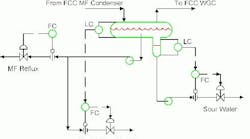While engineers often strive to keep processes running without too much variation, measurements that dont change may be a cause for concern not celebration, as one refinery can attest.
Many drums in hydrocarbon systems have water boots with separate water-level controllers for the hydrocarbon and water. Typical services with such overhead drums include atmospheric columns, coker main fractionators, visbreaker atmospheric columns and fluid catalytic cracker (FCC) main fractionators, among others.
At this refinerys FCC main fractionator, a fouled water-level measurement resulted in pump seal problems, motor troubles and high maintenance costs. Figure 1 shows the FCC main fractionator overhead drum and level control system.
Figure 1. Typical set-up includes two instruments to monitor water level, including one in the boot.
Immediately after a turnaround, the FCC started up without problems. However, after several weeks of operation, seal problems developed on the reflux pump. Some preliminary field troubleshooting reported that the pump was cavitating. The initial conclusion was that the net positive suction head available (NPSHA) was insufficient. This was puzzling because the pump had always worked before. NPSH is a convenient, but over-used, suspect to blame for pump problems.
At this point, someone proposed an alternative cause for the problem that the pump was damaged, creating a need for a higher NPSH. One pump of the two parallel pumps in the service was pulled and inspected. It showed no apparent reason for NPSH problems. Then, the design of the piping from the drum was checked. Again, no source of an NPSH problem was found.
Over time, the new operation was accepted as normal. However, the situation continued to nag on some of the operators. Further field data were gathered and compared to operating data. One observation immediately stood out as suspicious. The water level measured in the drum never seemed to vary. So, the connections to the water level instrument were blown out and the instrument placed back in service. The measured water level immediately jumped from 54% of range to 100%. The water level was above the upper-water-level tap. A plug in the line had blocked the instrument at 54% of range (Figure 2).
Figure 2. A plug in the line kept the instrument from responding to changes in water level.
Actual water level in the internal draw-off pipe to the reflux pump varied enormously, from nearly zero on up. Because water density is much higher than the naphtha density, sudden water slugs to the pump dramatically increased power load and caused pump damage.
Liquid levels that never vary should automatically raise suspicion. The same holds true for any variable. Measured values that never vary or respond to plant changes nearly always indicate stuck, damaged or poor instrumentation.
By Andrew Sloley, contributing editor
[email protected]


